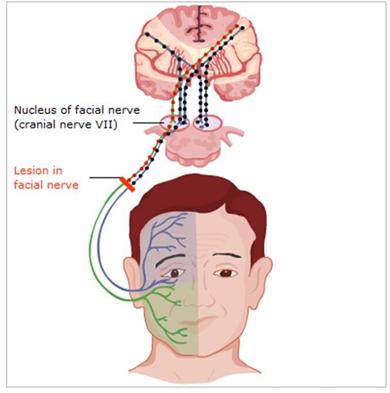
Facial Nerve Disorders – Paralysis and Bell’s Palsy. Face injuries and disorders can cause pain and affect how you look. In severe cases, they can affect sight, speech, breathing and your ability to swallow.
Facial Nerve Disorders . Download Facial Nerve Disorders Brochure . Michigan Ear Institute has been at the forefront in developing treatment modalities for facial nerve dysfunction including Bell’s palsy and traumatic facial nerve paralysis.


Learn what to look for when assessing patients with facial weakness.

Mar 07, 2016 · Because speech, mastication, and expression of moods and emotions are based on the ability to move facial musculature—be it voluntary or involuntary—successful treatment of facial nerve paralysis is a vital concern. This article informs the reader about the extracranial etiology of facial nerve
Central facial palsy (colloquially referred to as central seven) is a symptom or finding characterized by paralysis or paresis of the lower half of one side of the face.It usually results from damage to upper motor neurons of the facial nerve.




Facial nerve (7th cranial nerve) palsy is often idiopathic (formerly called Bell palsy). Idiopathic facial nerve palsy is sudden, unilateral peripheral facial nerve palsy. Symptoms of facial nerve palsy are hemifacial paresis of the upper and lower face. Tests (eg, chest x-ray, serum ACE level) are
The facial nerve, CN VII, is the seventh paired cranial nerve. In this article, we shall look at the anatomical course of the nerve, and the motor, sensory and parasympathetic functions of its terminal branches.
Chartered Physiotherapist, Caitriona Newham discusses the potential rehabilitation process for individual who have the disorder, Bell’s Palsy, which is also known as Facial Weakness.
SYNONYMS: Cranial nerve seven (VII), Nervus facialis COURSE OF FACIAL NERVE Supranuclear pathways 1. Somatomotor cortex: controlling motor component of facial nerve lies in precentral gyrus (Broadmann area 4,6,8) 2.

Signs and symptoms. Facial nerve paralysis is characterised by unilateral facial weakness, with other symptoms including loss of taste, hyperacusis, and decreased salivation and tear secretion.
